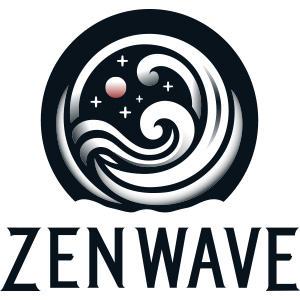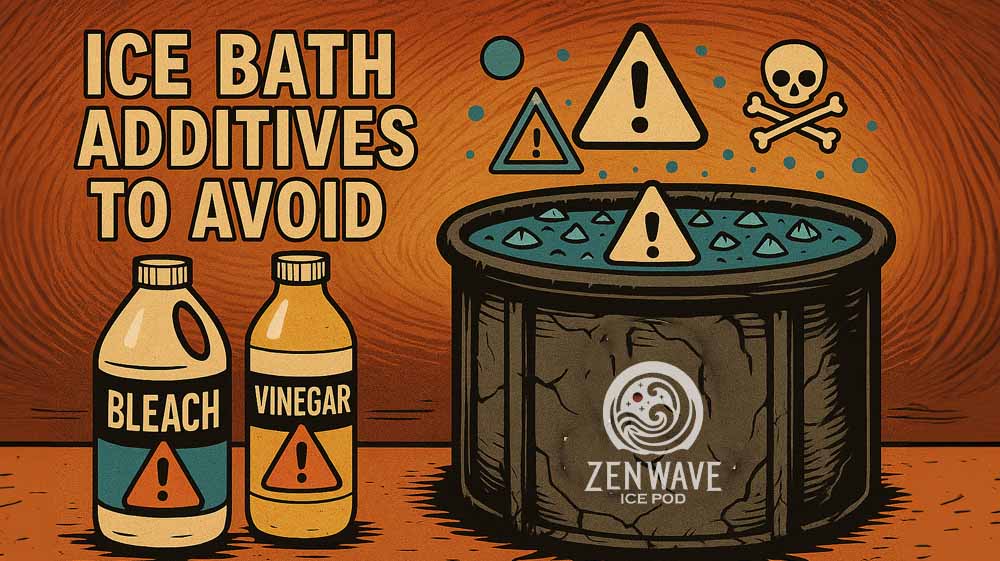The wrong additive won’t just ruin your water — it can corrode your tub, clog your chiller, and burn your skin.
As more people start using supplements, oils, and cleaners in their cold plunges, the line between helpful and hazardous gets blurry. Some additives work beautifully in one setup but cause silent damage in another. It all depends on the material of your tub, the strength of the dose, and how well you dilute or emulsify what you’re adding.
This guide shows you which ones are always a bad idea, which are conditionally safe, and how your tub material determines what works (and what could quietly destroy the expensive gear you’ve invested in.).
Why Some Ice Bath Additives Are Dangerous
Most of the time, it’s not the additive itself that’s the problem.
It’s how people use it:
- Wrong concentration (too much too fast)
- No dilution or emulsifier
- Tub material incompatibility
- Poor water circulation or no filtration
- Mixing it with other additives that react badly
We’re not here to scare you off. We’re here to show you where the real risks are — and how to avoid them.
Additives That Are (Almost) Always Unsafe
Many of these additives cause chemical or mechanical damage — not immediately, but over repeated exposure. Corrosive reactions, clogged components, or altered water chemistry are the usual suspects. Here’s what goes wrong and why.
These are the ones we recommend staying away from 99% of the time. Either because they corrode tubs, harm your skin, or leave behind a mess that’s hard to fix.
1. Household Bleach
Bleach is a powerful oxidizer. That might sound good in theory, but in practice it damages gaskets, breaks down rubber seals, and can cause serious skin irritation — especially in small, enclosed tubs with no overflow.
2. Pool Chlorine (Granules or Tablets)
Chlorine was built for pools, not cold plunges. It releases gases and chemical byproducts that aren’t meant to be soaked in at 40°F. It’s also notorious for corroding chiller components and liner adhesives.
3. Vinegar
Yes, it’s “natural.” But vinegar is still acetic acid — and in concentrated water, that acidity can corrode stainless steel, galvanized tanks, and fittings. It also throws off your water pH, making other additives less effective.
What’s more, vinegar breaks down protective zinc layers in galvanized steel — leading to rust seepage and structural decay over time.
4. Bath Bombs and Fragrance Bombs
These are loaded with artificial colors, sulfates, foaming agents, and perfume chemicals. Sulfates can disrupt water chemistry and break emulsifier bonds, making it harder to balance oils or pH. Even if they smell nice, they leave film, clog filters, and stain surfaces. Totally wrong environment.
5. Undiluted Essential Oils
Oils need emulsifiers. These are substances (like castile soap or polysorbate) that help oils blend evenly into water instead of floating on the surface. If you skip that step, oils float, cling to plastic, and irritate the skin. Worse, they trap organic debris that becomes biofilm food — and biofilm is incredibly hard to remove once established. Over time, oils gum up chillers and degrade soft-sealed linings.
6. Table Salt or Calcium Chloride
Salt in the wrong tub = corrosion. Especially with galvanized steel or any non-marine-grade metal. Chemically, salts break down protective layers like zinc or coatings and cause rust seepage or blistering under the surface. These salts also don’t dissolve well in cold water, leading to concentrated patches that can eat through liners and hardware.
Additives That Are Safe If You Use Them Right
These ingredients have real benefits — as we explain in our guide to the best ice bath additives, which breaks down performance, compatibility, and dosing for each option — but they need the right protocol. No eyeballing it. No shortcuts.
1. Epsom Salt
Amazing for recovery, magnesium absorption, and slush texture. Epsom salt improves magnesium absorption and helps turn water into slush below freezing. But it only works safely in the right tub setup — as detailed in our full guide to Epsom salt in ice baths. You need good filtration and the right tub. Avoid in galvanized setups. In stainless or HDPE? You’re good to go.
2. Hydrogen Peroxide (3%)
Stick to food-grade 3% at 2 oz (59 mL) per 10 gallons (38 L). Add it after your plunge, not before. Anything stronger than 3% starts to wear down rubber gaskets and chillers — and it’s harsh on skin, especially during longer soaks. For more on using this safely, check our guide on how to use hydrogen peroxide in ice baths.
3. Baking Soda
Great for balancing pH and softening water. Just don’t overdo it. A quarter cup (59 mL) per 80 gallons (303 L) is enough. More can mess with the chemistry and reduce microbial control.
4. Menthol Crystals
That “colder than cold” feeling? That’s menthol. But you must dissolve the crystals in hot water first. Direct contact will sting.
5. Tea Tree Oil (with Carrier)
Anti-microbial and refreshing. But only use it with a carrier oil like MCT or jojoba. Otherwise, it floats and burns. Add after filtration cycle for best results.
6. Copper Sulfate
Great for microbial control in stainless steel tubs only. Never use in galvanized steel — it reacts with the zinc and causes corrosion. Stick to trace amounts and test levels with strips.
What Ice Bath Additives Damage Different Tub Materials?
If your tub is made of the wrong stuff, even “safe” additives can turn on you.
| Tub Material | Additives to Avoid | Why It’s a Problem |
|---|---|---|
| Stainless Steel | Vinegar, undiluted essential oils, high-strength hydrogen peroxide (>3%) | Can cause pitting, corrosion, or staining—especially with frequent use |
| HDPE Plastic | Strong solvents, alcohols, concentrated peroxide or oils | May weaken plastic over time, leading to cracks or brittleness |
| Fiberglass / Acrylic | Pool chlorine, abrasive salts, undiluted oils | Vulnerable to surface damage, scratches, and discoloration |
| Galvanized Steel | Any salts, vinegar, peroxide | Salts and acids break down the zinc coating, causing rust and leaks |
| PVC (Portable Baths) | Fragrance bombs, bleach, oils | Soft materials absorb chemicals and lose flexibility, increasing risk of rupture |
| Wood (With Liner) | Any non-tub-safe additive | Even lined wood can absorb oils or acids that lead to swelling or decay |
| Chest Freezers (DIY) | Any corrosive additive — especially bleach or vinegar | Can destroy internal insulation and compromise electrical safety |
What to Use (and Avoid) Based on Your Ice Bath Goal
| Intent | ❌ Avoid This | ✅ Try This Instead |
|---|---|---|
| Disinfection | Bleach, pool chlorine | 3% hydrogen peroxide, tea tree + emulsifier |
| Muscle recovery | Table salt, bath bombs | Epsom salt (magnesium sulfate) |
| Sensory enhancement | Undiluted oils, fragrance bombs | Menthol crystals, tea tree oil (diluted) |
| Water clarity/algae | Vinegar, copper (in wrong tub) | Zinc sulfate, trace copper (stainless only) |
Additives Can Wreck Your Setup
Maintaining water quality isn’t just about smell — it’s about preventing microbial growth and system wear. Here’s how to keep your ice bath water clean using DIY filtration techniques that work with or without chillers.
Even the right additive can kill your chiller if you ignore maintenance.
- Salt and peroxide can oxidize metal pipes and fittings.
- Oils can clog filters or coat chillers.
- Unfiltered debris can lead to buildup, blockages, and biofilm.
And worst of all? Most manufacturers will void your warranty if damage is linked to chemical misuse. For more, read our guide on how to use and maintain a water chiller.
Additive Testing Cheat Sheet
To understand how additives affect water chemistry, see our breakdown on how pH and contamination affect your ice bath — especially if you’re using baking soda, vinegar, or peroxide.
Before you toss anything into your tub, test the basics:
- pH strips → For checking baking soda or vinegar effects
- TDS meter → For salt and mineral additive concentration
- Copper/zinc ppm strips → Essential for metal-based additives like copper sulfate or zinc
- Cloudiness/foam test → Stir your mix in a separate bucket — if it leaves residue, rethink the ratio
Safety Rules That Actually Work
If you want to use additives, use them like this:
- Know your tub’s material
- Stick to tested dosages
- Emulsify or dilute everything
- Use test strips for anything with minerals (zinc, copper)
- Never mix unknowns (especially acids + oxidizers)
Final Thoughts
Additives aren’t the enemy — misuse is. The right ones, used the right way, can make your ice bath cleaner, more effective, and more enjoyable. But the wrong ones (or even the right ones used carelessly) can destroy chillers, corrode your tub, and irritate your skin.
It comes down to three things: know your materials, understand your chemistry, and respect the process. If you’re willing to test, track, and stay consistent, you’ll get all the benefits without the blowback.
Still unsure? Start simple. Stick with a clean tub, filtered water, and a few proven additives. From there, you can dial in your stack like a pro — with less risk and better results.

